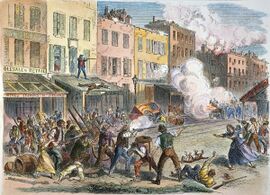Nullification Rebellion
| Nullification Rebellion | |||||||
|---|---|---|---|---|---|---|---|
 Vementrian militiamen in Bermund are fired on by Confederal troops | |||||||
| |||||||
| Belligerents | |||||||
|
|
| ||||||
| Commanders and leaders | |||||||
|
|
| ||||||
| Strength | |||||||
| 2,600 | 6,700 | ||||||
| Casualties and losses | |||||||
|
598 confirmed killed 1700 captured | 32 killed | ||||||
| Unknown number of civilians accidentally killed | |||||||
The Nullification Rebellion was a brief rebellion against the nascent confederal government of Ambrose that lasted from 20 January to 11 May 1852, in the then-thanedred of Vementry (modern day Rheneas and Scarfskerry). It followed on the heels of the Ambrosian Revolution, and raised the issue of thanedred sovereignty and the legality of confederation.
The rebellion began as an armed tax revolt, with whalers of the the maritime thanedred protesting the whale oil tax passed as part of the Maritime Revenue Act 1851. Under significant pressure, Vementry governor Nathaniel Fulwar Skipwith declared the tax "null and void" within the thanedred. Tensions between the thanedred and confederal governments escalated, and the crisis spiraled into armed insurrection when Skipwith called on the thanedred militias to occupy confederal arsenals on 2 April. This led to a coup d'etat in Elsbridge; the new military government under President Henry John Pinckney authorized military force against the rebels, and within a month, the rebellion had been brutally crushed by the Confederal Army.
The aftermath of the rebellion saw the question of thanedred nullification, left ambiguous by the Fundamental Articles, decisively answered. As a punitive measure, the thanedred of Cawdor was abolished, with its territories divided and prominent agitators imprisoned or executed. More broadly, the defeat of the rebels led to the marginalization of the anti-administration revolutionary ideologues within the confederal government, with President Pinckney suspending the House of Burgesses shortly thereafter in favor of military rule. It began a trend of administrative centralization in Elsbridge that would not be reversed until the return to civilian administration in 1872.